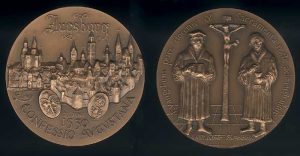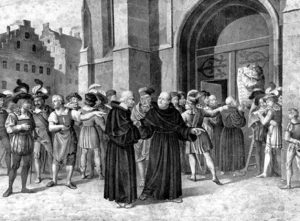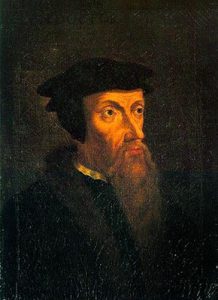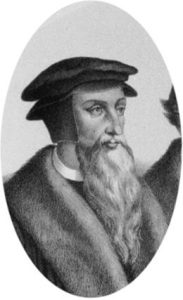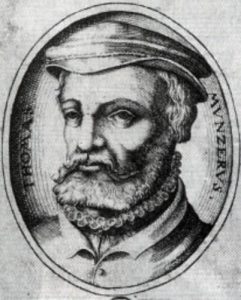The Protestant Reformation confirmed States and stabilised languages
In the 16th century the Protestant Reformation was directly linked to the establishment of nation-States. By enabling everyone to read the Scriptures and to pray God in their own language, it contributed to the development of, for example, the German, English, French and Swedish languages. Translation of the Bible by Luther, Tyndale, Lefèvre d’Etaples, Olivétan, and by Olaf Petersen helped national theological and philosophical literature emerge. Calvin’s L’institution de la Religion Chrétienne (The Institution of the Christian Religion), besides its original version in Latin, was translated into many versions in French, English, Spanish and Italian.
The connections between the re-established evangelical faith and the different States were far from straightforward. Luther benefited from the support of many German princes, the first being Frederic the Wise, Elector of Saxony; whereas Calvin, although he sent Francis I the foreword to his Institution, had to find his main support outside the kingdom of France. Countries of «Refuge» agreed to receive the Reformed faithful from Strasbourg to Geneva via Basel. The English situation was different as the Crown reorganised the Church, keeping bishops but giving the country a Protestant confession of faith: the Thirty-nine Articles (1563-1571) of the Anglican Reformation.
What is not so well known is that Scandinavian monarchies were the first to break with Catholicism. Lutheran ideas were preached in Denmark as early as 1520, and the Duke of Schleswig-Holstein invalidated removed bishops and conservative aristocrats before he became king under the name of Christian III. The country embraced the Lutheran Augsburg Confession. Gustave Vasa, in Sweden, set about de-consecrating Church property and preaching the Gspel, under the influence of Olaf and Laurent Petersen.
Several models of Reformation
In the 16th century the Reformation developed in four directions:
- the Lutheran Reformation started in Germany and was supported by the princes and some urban elements, whereas in Sweden it was supported by the Church and the sovereign,
- the Reformed branch started in Switzerland with Zwingli and in Geneva with Calvin, heavily relied on mainstream, or at least middle class, support,
- the Anglican Reformation, in England, dictated by the sovereign, took place in the church hierarchy
- The Radical Reformation started with mainstream elements in Germany and in Switzerland who reckoned that the Lutherans and the Reformed did not go far enough. For them the Reformation had stopped half-way, so they profoundly questioned the dogmas and ecclesiology of the Catholic Church.
Since they were led by theologians, the first three branches constituted the “Magisterial Reformation”.
The two models of Reformation – “Magisterial” and Radical – were sometimes in conflict: Luther was confronted by the peasants’ uprising in 1525, Calvin fought the Anabaptists and those he called “spiritual libertines”, blamed for causing social disorder or discord.
The Protestant Reformation was often historically expressed in contradictory ways, though it remained true to some strong statements, such as justification through faith, the great significance of grace, the precedence of the Bible over the ecclesiastical institution. Nevertheless, as Lucien Lefebvre declared, “should the Reformation be expressed in the singular, would it not be better in the plural?”
The term “Protestant Reformation” has the virtue of stressing the indisputable agreements between the different groups, considered as wealth and not as weakness in the world today, so familiar with pluralism. The ”variations among Protestant churches‘’, which Bossuet considered to be a proof of error, can conversely be taken as a demonstration of vitality and spiritual broad-mindedness.
.


